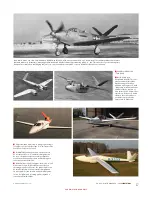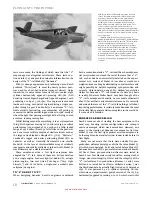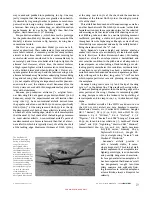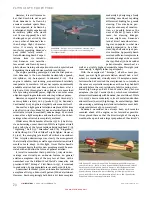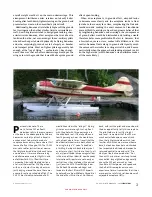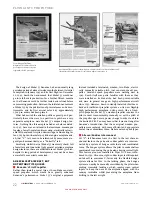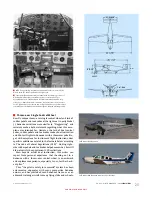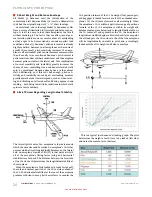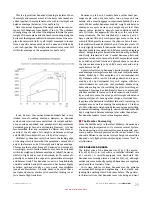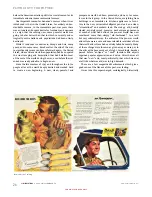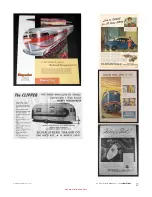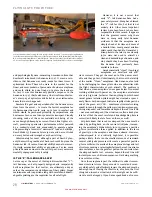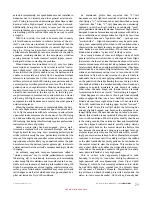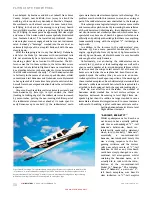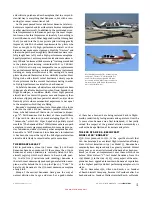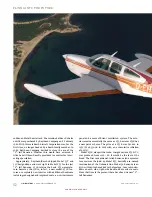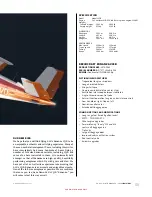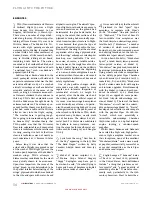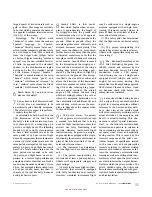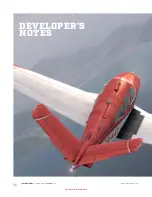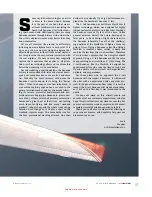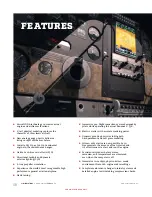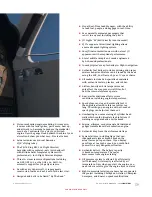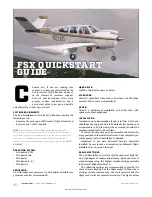
www.a2asimulations.com
ACCU-SIM V35B BONANZA
:::
A2A
SIMULATIONS
25
FOR SIMULATION USE ONLY
Bonanzas up to S and V models have a rather short pas-
senger cabin with only four seats, two up front and two
behind and a small baggage compartment behind the rear
seats. Whilst earlier Bonanzas models’ weight and balance
envelopes are quite narrow, one might expect that their
shorter cabins tended to keep aft load conditions within
safe CG limits, but apparently this was not the case in too
many situations. The last two Model 35 variants, S and V,
have optional fifth and sixth passenger seats in the rear
which if filled greatly increases the chance of an aft over-
load condition. Bonanza Models S and V’s rearmost safe CG
is only slightly farther aft than earlier four seat, short- cabin
Bonanza models (see weight and balance envelope diagram
above). Recognizing this potential hazard, Beech specifically
and firmly forewarned S and V model Bonanza pilots and
operators to take extra care not to load the aeroplane beyond
its published aft load limits and advised them to consider
the two rearmost seats to be child’s seats only and not to
seat adults so far aft.
A practical solution to Bonanza’s limited weight and bal-
ance envelope was largely resolved in the next major Bonanza
model, Model A36. This aeroplane is a conventional- tail
E33 Debonair with a ten- inch fuselage stretch and is pow-
ered by a 285 hp Continental IO- 520- B engine, with four
cabin windows on each side, rear starboard double entry
doors and seating for six, including the pilot. Stretching an
aeroplane’s fuselage has traditionally been a common and
effective method to increase its load capacity and flexibil-
ity as well as to move the aft edge of its weight and balance
envelope further aft. Among other things, a stretched fuse-
lage places the horizontal stabilizer father aft, increasing its
moment arm as well as moving the aeroplane’s CL farther
aft. This widens its weight and balance envelope permitting
increased aft loading. Accordingly, stretched Bonanza Model
A36’s weight and balance envelope is far wider than all ear-
lier Bonanza models (see envelope diagram above).
■
The Elevator Downspring
From the first Model 35 to the latest Model 36, Bonanza has
a downspring incorporated in its elevator control system.
The downspring, as its name implies, provides gentle, con-
stant, positive forward pressure on the control wheel. This
unusual addition to the control system helps to desensitize
Bonanza’s very light pitch control and give it more “feel” in
all situations..
THE BONANZA BONANZA
The initial price of the Bonanza was $7,345 (the equiva-
lent of $82,010.71 in 2018 with a cumulative inflation rate
of 1.016.6%.) A lavishly- equipped 2018 Beechcraft G36
Bonanza was recently placed on sale for $913,105, although
earlier and more modestly equipped Bonanzas are regularly
purchased for a fraction of that.
In its class and for its time, Bonanza was the epitome
of aeronautical design and engineering - fast, sturdy, and
looking like nothing which had come before. The particu-
lar historical time that Bonanza came into being and went
This is a typical (not Bonanza’s) loading calculator. When
the weight and moment arm of all the items to be loaded are
added together, the aeroplane must be within its weight and
balance envelope (below) or it is unsafe to fly.
Here is an actual diagram of the weight and balance enve-
lopes of all Bonanzas from Model 35 to A36. The numbers
running along the left side of the diagram indicate the gross
weight of the aeroplane and the numbers running along the
bottom of the diagram indicate the moment arm of the aero-
plane from forward (left) to aft (right) measured in inches
from a specific datum point near the nose and divided by
1,000 inch- pounds. The weight and moment arm must fall
within its envelope or the aeroplane is unsafe to fly.
It can be seen that earlier Bonanza models had a very
limited fore- aft loading envelope. However, as Bonanza
evolved and it carried more useful load, its weight and bal-
ance envelope expanded and aerodynamic improvements
permitted greater fore and aft loading. However, it is not
recommended that any aeroplane be flown very close or
exactly at the aft edge of its weight and balance envelope
and NEVER flown beyond it, even if by a tiny margin.
All Model 35 Bonanzas carry their fuel in the leading edge
of the wing which is forward of the aeroplane’s unloaded CG
and at the forward end of its weight and balance envelope.
This means that as fuel burns off, Bonanza’s CG moves aft.
Accordingly, a well- fuelled Bonanza may have been loaded
within its weight and balance envelope at takeoff, however,
whilst in flight and as fuel is consumed, its CG moves aft,
possibly to or beyond the edge of its permissible aft weight
and balance limit. This Bonanza is now in a longitudinally
unstable condition and pitch control and has become highly
sensitive, perhaps actually or very nearly uncontrollable
(see above discussion). It hardly needs to be stated that a
too light and overly sensitive pitch control at landing is a de
facto unsafe flight condition.
Summary of Contents for BONANZA ACCU-SIM V35B
Page 1: ...A2ASIMULATIONS BONANZA ACCU SIM V35B BONANZA ...
Page 3: ...A2ASIMULATIONS BONANZA ACCU SIM V35B BONANZA ...
Page 5: ...www a2asimulations com ACCU SIM V35B BONANZA A2ASIMULATIONS 5 FOR SIMULATION USE ONLY ...
Page 27: ...www a2asimulations com ACCU SIM V35B BONANZA A2ASIMULATIONS 27 FOR SIMULATION USE ONLY ...
Page 58: ......
Page 68: ...68 A2ASIMULATIONS ACCU SIM V35B BONANZA www a2asimulations com FOR SIMULATION USE ONLY ...
Page 112: ......







